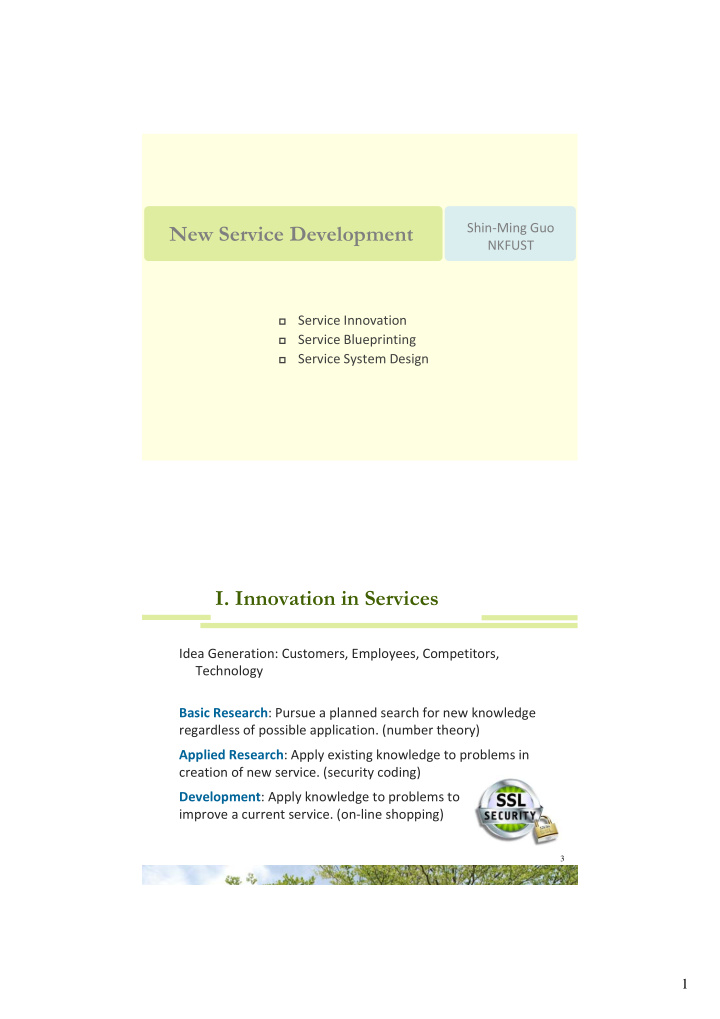



New Service Development Shin ‐ Ming Guo NKFUST Service Innovation Service Blueprinting Service System Design I. Innovation in Services Idea Generation: Customers, Employees, Competitors, Technology Basic Research : Pursue a planned search for new knowledge regardless of possible application. (number theory) Applied Research : Apply existing knowledge to problems in creation of new service. (security coding) Development : Apply knowledge to problems to improve a current service. (on ‐ line shopping) 3 1
Technology-Driven Service Innovations Source of Service Example Service Industry Impact Technology Power/energy Jet aircraft International flight is feasible Facility design Hotel atrium Feeling of Enclosed sports stadium grandeur/spaciousness Year ‐ around use Materials Photochromic glass Energy conservation Synthetic engine oil Fewer oil changes Methods Just ‐ in ‐ time (JIT) Reduce supply ‐ chain inventories Six Sigma Institutionalize quality effort Information e ‐ commerce Increase market to world ‐ wide Internet Video on demand 4 Process Innovation Change where the process occurs relative to where the customer is. Electronic commerce: Holds inventory in a warehouse far from customers and ship the inventory to customers upon order Long tail effect : allows more variety – items with little demand for a local store can be profitably carried in an order fulfillment center Customers order from home but have to wait and shipping costs must be incurred. 5 2
Challenges for Service Innovation Limited ability to protect intellectual properties. Definition of the intangibles. Incremental nature of innovations. Limited ability to build prototypes or conduct tests 6 II. Service Design location, Customer interior design Supporting Facility Participation service blueprint, Facilitating Goods service recovery Simultaneity Information revenue Perishability management Explicit Services Intangibility Implicit Services service encounter Heterogeneity capacity planning, waiting line management 3
Service Design Elements Design Elements Topics Structural Delivery system Process structure , service blueprint, strategic positioning Facility design Servicescapes, architecture, process flows, layout Location Geographic demand, site selection, location strategy Capacity planning Strategic role, queuing models, planning criteria Managerial Information Technology, scalability, use of Internet Quality Measurement, design quality, recovery, tools, six ‐ sigma Service encounter Encounter triad, culture, supply relationships, outsourcing Managing capacity Strategies, yield management, queue management and demand 8 Strategic Positioning via Process Structure Degree of Complexity : Measured by the number of steps in the service blueprint, e.g., a clinic is less complex than a general hospital Degree of Divergence : Amount of discretion permitted the server to customize the service, e.g., the activities of an attorney contrasted with those of a paralegal 10 4
Structural Alternatives for a Restaurant 11 Structural Alternatives for a Restaurant 12 5
Service Process Matrix: Divergence 13 Service Blueprinting: Complexity 14 6
Failsafing (pokayokes) Service failures are often caused by interruptions or negligence. Task to be done Treatment accorded to the customer Tangible features of the service Service Encounter = moments of truth Every customer contact is an opportunity to satisfy the customer. To improve customers’ perception of service quality. 15 Generic Approaches to Service Design Production ‐ line • Low Divergence • Service Flow • Cost and Consistent Quality Customer as Co ‐ Producer • Low Complexity, High Divergence • Substitute Technology for People • Cost and Convenience Customer Contact • High Complexity, High Divergence • Service Encounter, Service Guarantee • High Performance Quality, Dependability 16 7
Service Design Example 1 Production Line Treat the service as a manufacturing process Focus on tangibles, not people Standardization uniform quality Low contact high efficiency Technology fool ‐ proofing equipment and process 17 Service Design Example 2 Customer as Co ‐ Producer having customers taking a greater role enhances the service Self service cost, speed, convenience, customization 24 7 service availability Appointments and reservations Customers generated content Wiki, e ‐ markets 18 8
Service Design Example 3 Customer Contact how to achieve efficiency with customer participation Separation of high and low contact operations Employee empowerment + Keep track of customers’ preferences total customization of service Sales opportunities via personal relationship 19 Case Study: Car Sharing Best suited to urban locations where there was a dense base of potential users, parking was expensive, and the need to drive was limited. Big hole in the rental market: short ‐ term, on ‐ demand private car access. 9
Building Service Platform • Mobile technology enables vehicle reservation and usage. • Wireless transmission authorizes users, read odometer, mileages, and time stamps. Guidelines for Successful Service Design 1. Define the service package in detail 2. Focus on customer’s perspective (expectation and perception) 3. Recognize that designer’s perspective is different from the customer’s perspective 4. Define quality for tangible and intangibles elements 5. Make sure that recruitment, training, and rewards are consistent with service expectations 6. Establish procedures to handle exceptions 7. Establish systems to monitor service 22 10
Conclusion • The process is the product. • Service ‐ system matrix ≈ product ‐ process matrix • Service blueprint ≈ process flow chart • Inventory and scheduling are often not available to service operations. • Expect and manage variability of service encounter • Parts of the service packages are defined by the training and treatment the workers receive. 23 Homework 2 • Study the operation of zipcar and analyze the service package and key design elements. • Due 12:00 noon, 3/31 • smguo@nkfust.edu.tw 11
Recommend
More recommend